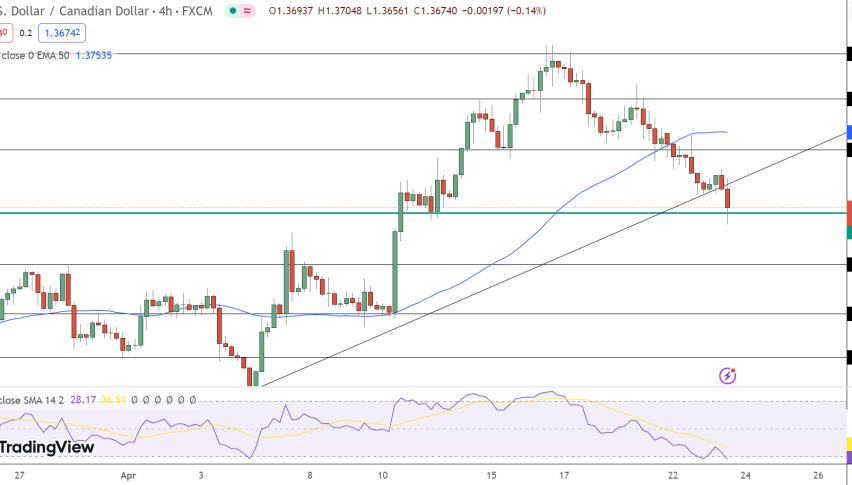
US Session Forex Brief, Apr 30 – Disappointing Chinese Data, Mixed Eurozone Data, the USD Bears the Burden
The market sentiment continued to deteriorate at the end of last year and the start of this one as the global economy slowed down considerably. The manufacturing sector fell into contraction for three months and the Eurozone manufacturing activity fell into an even deeper contraction in March. But, the economic data from China showed us last month that the manufacturing activity had made a turnaround and jumped back into expansion. Both Manufacturing PMI and Caixin manufacturing numbers were quite impressive after being below the 50 flat level for several months.
That improved the sentiment in financial markets, hence the bearish reversal in safe havens such as Gold and the climb in risk assets such as stock markets. China coming back to growth means one less thing to worry regarding the global economy.
But, last night the numbers were disappointing. Manufacturing PMI missed expectations and declined from last month, although this sector still remains in a decent shape, while manufacturing not so much. Caixin manufacturing and the manufacturing PMI reports showed that this sector is back to almost flat. Was last month’s jump just a seasonal adjustment? Is the global economy still headed towards recession after this month’s Eurozone manufacturing sector confirmed the deep dive?
The economic figures from the Eurozone today weren’t that bad, they were sort of mixed with consumer spending declining for the fourth time in the last five months and inflation weakening further in France. Although, inflation picked up in Germany and in Spain, while the unemployment rate ticked lower in the Eurozone and the GDP for Q1 beat expectations coming at 0.4% against 0.2% in the last two quarters.
European Session
- GDP Reports From Europe – Today is a GDP day, which kicked off with numbers from France early this morning. Economic growth has been weakening in France in the last year but at least it is remaining stable in the last two quarters. Q4 of last year stood at 0.3% and this quarter was expected to remain the same, which it did. Things have been better in Spain as growth has averaged around 0.6%-0.7% in the last several quarters. Growth for Q1 2019 was expected to be at 0.6% but it beat expectations ticking higher to 0.7%. Although, Q4 of last year was revised a tick lower to 0.6%. In Italy things have been pretty bad recently after a 0.1% decline in Q3 2018 and a 0.2% decline in Q4, which was revised higher today to -0.1%. But that still meant recession since it is two consecutive declines. The economy was expected to shrink by 0.1% again in Q1 of this year, but today’s report showed a 0.2% increase instead. So hopefully, things will get better in Italy. The GDP figures for the whole of the Eurozone were also released and showed a 0.4% expansion against 0.3% expected and up from 0.2% in the last two quarters.
- Inflation Reports From Europe – We also had a number of inflation reports being released today. The regional numbers have been coming out all morning from Germany and they looked upbeat, which gave away the positive number for the whole country . Consumer price index (CPI) inflation increased by 1.0% this month, double the 0.5% estimated. Although import prices fell flat at 0.0%, CPI is the most important number for inflation. In Spain, inflation came higher again at 1.5% on an annualized basis, up from 1.0% in January and 1.3% last month. But inflation missed expectations in France and Italy coming at 0.2% for both countries, against 0.3% expected.
- German GfK Consumer Climate – The consumer climate has been declining since the beginning of last year when it stood at 11 points. It fell to 10.4 points at the end of last year but we saw a jump in the first two months to 10.8 points. But last month we saw another dive to 10.4 points while this month it was expected to tick lower still to 10.3 points. But, it beat expectations and remained unchanged at 10.3 points.
- Unemployment Figures From Europe – German employment change has been negative, meaning that jobs and employment have been increasing. Today employment change was expected to come at -6k but beat expectations coming at -12k. In Italy, the unemployment rate jumped higher to 10.7% in February as last month’s report showed, but that was revised down to 10.5% today. The unemployment rate for March was expected at 10.6% but it moved considerably lower to 10.2%. For the whole of the Eurozone, the unemployment also declined, ticking lower to 7.7% from 7.8% previously.
The US Session
- Canadian GDP – The GDP sequence continued into the US session with Canadian GDP being released a while ago. The GDP misses expectations which were pretty low, coming at -0.1% against 0.0% anticipated. The Canadian economy took yet another dive after the 0.3% jump in January. It seems now that January’s jump was just a fluke with this being the fourth decline in the last six months. Year-on-Year GDP also missed expectations of 1.4% and instead came three points lower at 1.1%, down from 1.6% previously. Raw material price index also came much lower than the previous reading at 2.8% from 4.6% previously.
- US Employment Cost Index – The employment cost index, which is another indicator of how fast wages are growing, has been averaging at 0.7% in since Q4 2017. The Q1 was expected to remain at 0.7% and it remained unchanged indeed.
- US Chicago PMI – The Chicago PMI indicator which shows the level of a diffusion index based on surveyed purchasing managers in the Chicago area used to be at 65 points at the end of last year, but it started wobbling and weakening since then, although it remained at pretty solid levels at around 59 points. This month it was expected to increase to 59.1 points from 58.7 previously, but it posted a massive decline, falling to 52.6 points. This is a red flag for the US economy and for the FED.
- US CB Consumer Confidence – The consumer confidence deteriorated at the end of last year, although we have seen it make a turnaround in the last few months. Last month this indicator increased to 14.1 points and this month it was expected at 126.2 points. But it beat estimates, jumping to 129.2 points, so this is a green flag.
Bearish AUD/USD
- The main trend is bearish
- The pullback higher is complete
- Fundamentals turned negative again

The 100 SMA provided solid resistance last Friday
We have an open signal in this pair, having gone short earlier. I was worried yesterday for this signal since the retrace higher wasn’t stopping, but last night the soft manufacturing figures from China turned the fundamentals against the Aussie. Besides that, the main trend still remains bearish for this pair and the pullback higher is complete. Actually, this pair is reversing down now, so we are safe with our trade here.
In Conclusion
The CAD has turned bearish after yet another decline in the GDP. The USD also turned even more bearish after the soft Chicago PMI indicator, but the jump in the CB consumer confidence is helping the buck at the moment, which is reversing to bullish. Although, I don’t expect much action in either direction until the FED meeting tomorrow evening.












